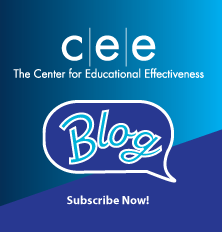
CEE Blog
Welcome to the CEE Blog
Our goal is to spark ideas and inspire educational improvement. We are partnering with experts, authors and researchers to bring you relevant, timely and creative ways to support your work and professional growth.
The Four Domains of Wellness: A Look at the Student Universal Wellness Screener (SUWS)
Screener data, by itself, will not result in improved outcomes for systems or the students they serve. Screener data that is actionable requires professionals to take action. While this seems patently obvious, it warranted being addressed by Romer et al (2020): “There is an ethical responsibility to enact meaningful decisions on said data (i.e., “screen to intervene”). It is unethical to collect data that requires the use of school time and/ or resources, without utilizing the data to inform service delivery.”
This means that even if districts understand the research-backed rationale for using a SEB screener, and remove barriers to commitment, and follow a best-practice roadmap to implementation, nothing will have changed if action is not taken to change what students see, hear, and experience as a result.
Best Practices for District-Wide Implementation of SEB Screenings
In this 3rd of our 4-part series, we will turn our attention to creating the roadmap for and indicators of a successful multi-faceted SEB screener implementation.
Setting the Stage for SEB Screenings
The journey toward implementing Social Emotional Behavioral (SEB) screenings is rooted in a deep-seated recognition of their intrinsic value: these screenings are a pivotal element in sculpting an educational environment that not only nurtures academic prowess but also fortifies the mental and emotional resilience of students. It is a proactive stance, one that underlines the commitment of educational leaders to embrace the multifaceted nature of student growth and well-being. By instituting SEB screenings, schools lay a strong foundation for a support system that is attuned to the holistic needs of students, recognizing that academic success is inextricably linked to social and emotional health.
Embracing SEB screenings is, therefore, a strategic and research-informed decision that can lead to a transformative educational culture—one where every student can thrive in a supportive and nurturing environment. The following items provided are the road markers districts need to be aware of to determine whether they are on the road to a quality implementation of a screener or veering off course.
Next Level Leadership Course Launches - Marketing Your School - Who’s Telling Your Story?
Today’s blog provides insight into the driving force for the NLL Courses being developed and in particular the first course on effectively marketing your educational organization.
Ready, Set, Grow! Back-to-School Resources for Busy Educational Professionals
In this blog, Ready, Set, Grow! Back-to-School Resources for Busy Educational Professionals, we provide a guide to the most important content about transforming your system to positively impact the work that you are so passionate about.
Design Thinking Starts with Empathy
Begin with empathy, and you will accelerate the effectiveness and efficiency of your efforts. Today’s blog provides a rationale and examples of how empathy leads to lasting and powerful learning experiences fostered by innovation.
Taking Care of Business – but Who Takes Care of You?
The principle of taking time to “sharpen the saw” as Stephen Covey recommended sounds great but for busy administrators it is easy to get lost in the sawdust. Today’s blog will provide a rationale for why professional mentors and coaches are vital relationships designed to help you stay sharp.
Empower Others to Power Leadership Excellence
In this series titled “Administrator Self-Care and Resilience by Design,” we will focus on actionable strategies that directly impact administrators and, as a result, positively impact the work of all others in their care.
To Set Your Course, You Must First Know Where You Are - Part 1
It seems across all sectors, and education is no different, too often we do not have consensus around how to improve the current reality. When we do not know what our next critical work is as an organization, we can expend precious resources (time and money) applying solutions to problems that do not exist.
To Set Your Course, You Must First Know Where You Are - Part 2
In my last piece as a guest contributor, we covered the critical need to have actionable data to help our systems navigate through and beyond the COVID 19 pandemic. The title, To Set Your Course, You Must First Know Where You Are, applies to the following four data domains that we work in as professional educators: demographic, perceptual, contextual, achievement.
You Have Set Your Course; Is That Enough? Part 3
In my first two pieces as guest contributor, we focused on the urgency of what some refer to as the “twin pandemics,” social unrest and COVID 19, causing us to need access to high quality data to ensure we are framing the issues unique to each school system during these tumultuous times. In addition to having high quality data to frame clear problems of practice, it is essential each school organization consistently measure and build high-quality culture, as absent high-quality culture, little work benefitting children gets done.
What Gets In The Way of Moving Quickly To Serve Our Students? - Part 4
Most schools are good, defined as providing the expected opportunities leading to expected achievement for children. The opportunity gap is created by factors either outside of a school’s control or at the maximum, factors schools can influence but cannot control. The question then becomes, what happens inside of those very few exceptional schools where we see student achievement at levels the school’s demographic would not predict?
Putting It All Together - Part 5
In this five-part blog series I have questioned policy and practice, over reliant on standardized test scores and indirectly the standardized movement, against the stark reality of few schools providing transformative opportunities for students inside of their school systems.














